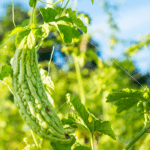Get More Out of Your Garden: How to Double Your Tomato and Cucumber Yields
As the saying goes, “you reap what you sow.” This is especially true when it comes to gardening and growing vegetable crops. To ensure a bountiful harvest of healthy and delicious vegetables, gardeners need to provide their plants with the necessary nutrients to thrive. In this post, we’ll explore some effective and natural ways to fertilize tomato, cucumber, and other vegetable crops, which can double yields.
The Importance of Fertilizing Vegetable Crops
Vegetable crops require various essential nutrients to grow and produce abundant yields. These nutrients include nitrogen, phosphorus, potassium, calcium, and magnesium, among others. The soil in which these plants grow can become depleted of these nutrients over time, which can lead to poor growth, low yields, and even plant diseases.
Fertilizing vegetable crops is crucial to maintain the soil’s nutrient levels, promote healthy plant growth, and increase yields. Using natural fertilizers, such as those discussed below, can help provide the necessary nutrients to support healthy growth and high yields.
Natural Fertilizers for Vegetable Crops that can help double your yield
Natural fertilizers are derived from organic sources, such as animal manure, compost, and plant materials. Unlike synthetic fertilizers, natural fertilizers are free from harmful chemicals and provide a range of nutrients to promote soil health and plant growth. Here are some effective natural fertilizers for vegetable crops:
Animal Manure
Animal manure is a rich source of organic matter, nitrogen, phosphorus, and potassium. It also contains other essential nutrients like calcium, magnesium, and sulfur. Using well-rotted manure can help improve soil fertility, increase water-holding capacity, and promote healthy plant growth.
When using animal manure as a fertilizer, it’s essential to let it compost for at least six months before applying it to your vegetable crops. This helps to kill any harmful bacteria or pathogens that may be present in the manure.
Compost
Composting is an excellent way to recycle organic waste and create a nutrient-rich soil amendment for vegetable crops. Compost is made by combining organic materials such as kitchen scraps, yard waste, and leaves and allowing them to decompose over time. The resulting compost is rich in nitrogen, phosphorus, potassium, and other essential nutrients.
Using compost as a fertilizer can help improve soil structure, increase water-holding capacity, and promote healthy root development in vegetable crops. It’s best to apply compost in the spring or fall before planting or as a side-dressing during the growing season.
Bone Meal Powder: A Nutrient-Rich Fertilizer for Your Vegetable Crops
Bone meal powder is a natural fertilizer derived from finely ground animal bones. It is a slow-release fertilizer that provides a balanced blend of nutrients, including phosphorus, calcium, and trace minerals. One of the significant advantages of bone meal powder is its odorless nature, making it a preferred choice for gardeners who are sensitive to strong smells.
Phosphorus, one of the primary nutrients found in bone meal powder, plays a crucial role in promoting root development, flower formation, and fruit production in vegetable crops. Calcium, another essential element, helps strengthen cell walls, reducing the risk of diseases and disorders in plants. Additionally, bone meal powder contains trace minerals like magnesium and zinc, which contribute to overall plant health.
Using bone meal powder is relatively simple. Before planting, incorporate it into the soil by mixing a recommended amount into the planting hole or along the planting rows. This ensures that the nutrients are readily available to the developing roots. Alternatively, you can apply bone meal powder as a top dressing around established plants, gently working it into the soil surface and watering it in.
The slow-release nature of bone meal powder means that its nutrients are gradually released over time, providing a consistent supply of nourishment to your vegetable crops. This makes it particularly beneficial for long-term growth and development. However, it’s essential to note that bone meal powder is primarily a phosphorus-rich fertilizer and may not provide sufficient nitrogen for plant growth. Therefore, it’s recommended to supplement with nitrogen-rich fertilizers if needed.
To achieve optimal results, follow the instructions provided by the manufacturer for the appropriate dosage and application frequency. Generally, applying bone meal powder once or twice a growing season is sufficient for most vegetable crops. Remember to water the plants thoroughly after application to ensure proper nutrient absorption.
In addition to its nutrient benefits, bone meal powder also contributes to soil health. It improves soil structure, increases moisture retention, and encourages beneficial microbial activity. By enhancing the overall fertility of your soil, bone meal powder promotes the long-term success of your vegetable garden.
Bone meal powder is a valuable and odorless fertilizer that provides essential nutrients for the healthy growth of your vegetable crops. Its balanced blend of phosphorus, calcium, and trace minerals supports root development, flower formation, and fruit production. By incorporating bone meal powder into your gardening routine, you can enhance soil fertility, promote plant health, and enjoy bountiful yields from your vegetable garden.
Looking for an odorless bone meal powder for your vegetable crops? Check out Shehri Kisaan Bone Meal Powder – a natural and organic fertilizer that’s safe for your plants and the environment. Order now at https://shehrikisaan.com and get ready to boost your harvest!
Liquid Organic Fertilizer
Liquid organic fertilizers are an excellent choice for vegetable crops as they’re quickly absorbed by plants, providing an immediate nutrient boost. They’re made from natural sources like seaweed, bone meal, and fish emulsion and contain a range of essential nutrients like nitrogen, phosphorus, and potassium.
To use liquid organic fertilizer, dilute it with water according to the manufacturer’s instructions and apply it to your vegetable crops as a foliar spray or soil drench. It’s best to apply liquid organic fertilizer every two to four weeks during the growing season.
Fertilizing Tomato and Cucumber Crops
Proper fertilization is crucial for achieving optimal yields in your tomato and cucumber crops. These plants have specific nutritional needs that must be met throughout their growth cycle. By providing them with the right balance of nutrients, you can encourage vigorous growth, abundant flowering, and bountiful fruit production. Let’s explore some key considerations when it comes to fertilizing tomato and cucumber crops.
Understanding Nutrient Requirements
Tomato and cucumber plants require a combination of macro and micronutrients for healthy growth. The primary macronutrients include nitrogen (N), phosphorus (P), and potassium (K), which are needed in relatively large quantities. Additionally, they require secondary nutrients like calcium (Ca), magnesium (Mg), and sulfur (S), as well as essential micronutrients such as iron (Fe), manganese (Mn), zinc (Zn), copper (Cu), boron (B), and molybdenum (Mo).
Soil Testing and Analysis
Before applying any fertilizers, it’s essential to conduct a soil test to determine the existing nutrient levels and pH of your soil. This analysis will provide valuable insights into the specific nutrient deficiencies or imbalances in your soil. Based on the results, you can make informed decisions about the type and quantity of fertilizers to apply.
Organic vs. Synthetic Fertilizers
Both organic and synthetic fertilizers can be used to nourish tomato and cucumber crops. Organic fertilizers, such as compost, manure, and bone meal, provide slow-release nutrients and improve soil health over time. On the other hand, synthetic fertilizers offer precise nutrient ratios and immediate availability but may lack the long-term benefits of organic amendments. Choose the fertilizer type that aligns with your gardening principles and preferences.
Timing and Application Methods
Proper timing and application methods are crucial for effective fertilization. Tomato and cucumber plants have different nutrient requirements at different stages of their growth. It’s essential to provide them with the necessary nutrients when they need them the most. Start by incorporating a balanced fertilizer into the soil before planting. As the plants grow, side-dress them with a nitrogen-rich fertilizer to support leafy growth. During flowering and fruiting, switch to a phosphorus and potassium-rich fertilizer to promote blooming and fruit development.
Avoid Over-Fertilization
While providing adequate nutrients is essential, it’s equally important to avoid over-fertilization. Excessive fertilization can lead to nutrient imbalances, burn the plants’ roots, or contribute to environmental pollution. Follow the recommended application rates on the fertilizer packaging and monitor your plants for signs of nutrient deficiency or excess. Adjust the fertilizer application accordingly to ensure optimal nutrient uptake and plant health.
Supplementing with Organic Matter
In addition to traditional fertilizers, incorporating organic matter into the soil can greatly benefit tomato and cucumber crops. Organic matter improves soil structure, enhances moisture retention, and promotes beneficial microbial activity. Consider adding compost, well-rotted manure, or other organic amendments to enrich the soil and provide a steady release of nutrients over time.
Mulching for Moisture and Nutrient Retention
Mulching around your tomato and cucumber plants can help conserve soil moisture, regulate soil temperature, and suppress weed growth. Organic mulches, such as straw, grass clippings, or wood chips, gradually decompose, releasing nutrients into the soil. This natural breakdown process adds organic matter and enriches the soil, benefiting your crops in the long run.
Watering and Fertilizer Uptake
Proper watering practices are essential for maximizing fertilizer uptake by your tomato and cucumber plants. Water the plants deeply and consistently, ensuring the moisture reaches the root zone. This encourages the efficient absorption of nutrients from the soil. Avoid overwatering, as it can lead to nutrient leaching and root rot. Monitor the moisture levels in the soil and water your plants only when necessary.
Foliar Feeding
In addition to root absorption, foliar feeding can be an effective way to deliver nutrients directly to the leaves of tomato and cucumber plants. Foliar sprays containing micronutrients can help address deficiencies quickly and improve overall plant health. When applying foliar sprays, ensure that the leaves are thoroughly coated with the solution, especially the undersides where nutrient absorption is most efficient.
Crop Rotation and Companion Planting
To maintain soil fertility and minimize nutrient depletion, practice crop rotation and companion planting. Rotating your tomato and cucumber crops with different plant families each season can help break pest and disease cycles, prevent nutrient imbalances, and improve overall soil health. Companion planting involves growing compatible plants together to enhance nutrient uptake and discourage pests. For example, planting basil near your tomatoes can improve their flavor and repel pests.
Regular Monitoring and Adjustments
Successful fertilization requires regular monitoring of your tomato and cucumber plants. Keep an eye out for any signs of nutrient deficiencies or excesses, such as yellowing leaves, stunted growth, or leaf burn. Adjust your fertilization regimen accordingly based on the specific needs of your plants and the feedback they provide. Regular monitoring and adjustments will help you maintain a healthy nutrient balance and maximize yields.
Sustainable Practices for Long-Term Success
In addition to fertilizing your tomato and cucumber crops, adopting sustainable gardening practices can contribute to long-term success. These practices include soil conservation, composting, reducing chemical inputs, and promoting biodiversity. By taking care of the soil and creating a balanced ecosystem in your garden, you can support the health and productivity of your plants while minimizing negative impacts on the environment.
Conclusion
Fertilizing tomato and cucumber crops is a crucial aspect of successful gardening. By understanding the nutrient requirements, conducting soil tests, choosing appropriate fertilizers, and implementing proper timing and application methods, you can promote healthy growth and maximize yields. Remember to monitor your plants, adjust your fertilization practices as needed, and incorporate sustainable gardening practices for long-term success. With these strategies in place, you’ll be well on your way to enjoying abundant harvests of delicious tomatoes and cucumbers straight from your garden.










